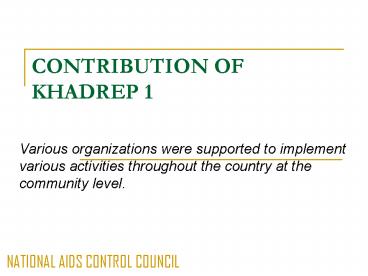CONTRIBUTION OF KHADREP 1 PowerPoint PPT Presentation
1 / 12
Title: CONTRIBUTION OF KHADREP 1
1
CONTRIBUTION OF KHADREP 1
- Various organizations were supported to implement
various activities throughout the country at the
community level.
2
Introduction
- Definition of community
- For the purpose of this presentation, the word
community refers to - People, organizations, structures at the
decentralized levels.
3
The supported programmes focused mainly on the
following areas
- Advocacy and prevention
- Treatment care and support for the infected and
affected - Mitigation of the socio-economic impact of
HIV/AIDS
4
PROGRESS
- Communities empowered to participate in HIV/AIDS
prevention strategies - Region with high level of awareness have moved on
to include other strategies like treatment, care
and support for the infected and affected - Increased campaign, free discussion and
acceptance of HIV/AIDS interventions at the
community level. - Some networking and collaborative meetings,
forums for joint planning, prioritization and
management.
5
CHALLENGES
- Insufficient capacity among implementing
organizations and community structures (CACCs and
DTCs) - Wrong perception of CACCs by communities as
financing organs - Mistrust,competion and suspicion among CBOs
(unwillingness to share information among
different groups) - Duplication of programmes and activities among
CBOs - Limited availability of comprehensive care
services at the community level.
6
LESSONS
- The already increased advocacy for attitude and
behavioral change needs to be sustained. - Irrespective of increased advocacy and awareness,
stigma is still high and more needs to be done. - Capacity differences among groups/organizations/in
stitutions hinders establishment of partnerships
amongst stakeholders thus the need to enhance
support for co-ordination efforts. - Role of MPs-support versus interference continues
to be a challenge - Need for Donor co-ordination to harmonize funding
at the community level.
7
- MAP II RECOMMENDATIONS FOR COMMUNITY SUPPORT
8
RECOMMENDED SUPPORT AREAS
- Community mobilization efforts
- Emphasis on support for capacity development and
empowerment of communities with a view of
ensuring sustainability of programmes. - scale-up of community programs especially
targeting previously marginalized areas and
focusing on highly vulnerable groups and high
impacted groups e.g. girls,women and orphans. - Aim at ensuring quality of community
interventions as opposed to quantity. - Enhancing community partnerships through
networking and collaboration
9
Institutional strengthening for community
participation and development
- Capacity needs assessements for CACCs and DTCs
- Provision of support for capacity building for
the AIDS decentralized structures-CACCs and DTCs
based on identified capacity gaps. - Leadership training and programme support
including financial management, disbursement, and
audits and M E. - Improving coordination between district and
constituency-level structures.
10
3. Research
- Identification of priority needs per region to
determine type and focus of interventions. - Rapid assesements of the number and level of
priority focus groups (vulnerable
groups)-OVCs.young girls etc (as in the KNASP) - Situational analysis to determine all
implementing organizations and the nature of
their activities at the community level. - better documentation of implementation processes
strategies lessons learnt and impact of
interventions - Impact assesements
- Identification of best practices with a view of
enhancing support to these organizations.
11
4. Monitoring and Evaluation (ME)
- Support the decentralized structures-CACCS and
DTCs undertake regular monitoring of community
programmes.
12
Financial support to community initiatives
- This should be based on the priority areas and
focus identified per region and based on the
KNASP focus areas as outlined below - Prevent new infections,
- Improve the quality of life of those infected and
affected, and - Mitigate the socio-economic impact of the epidemic

